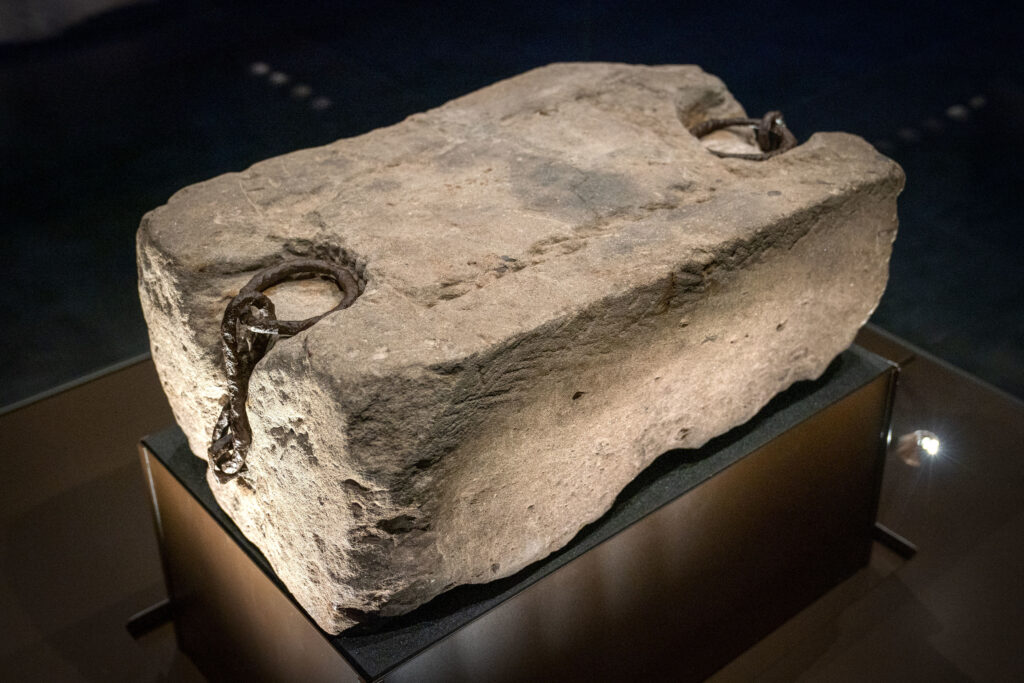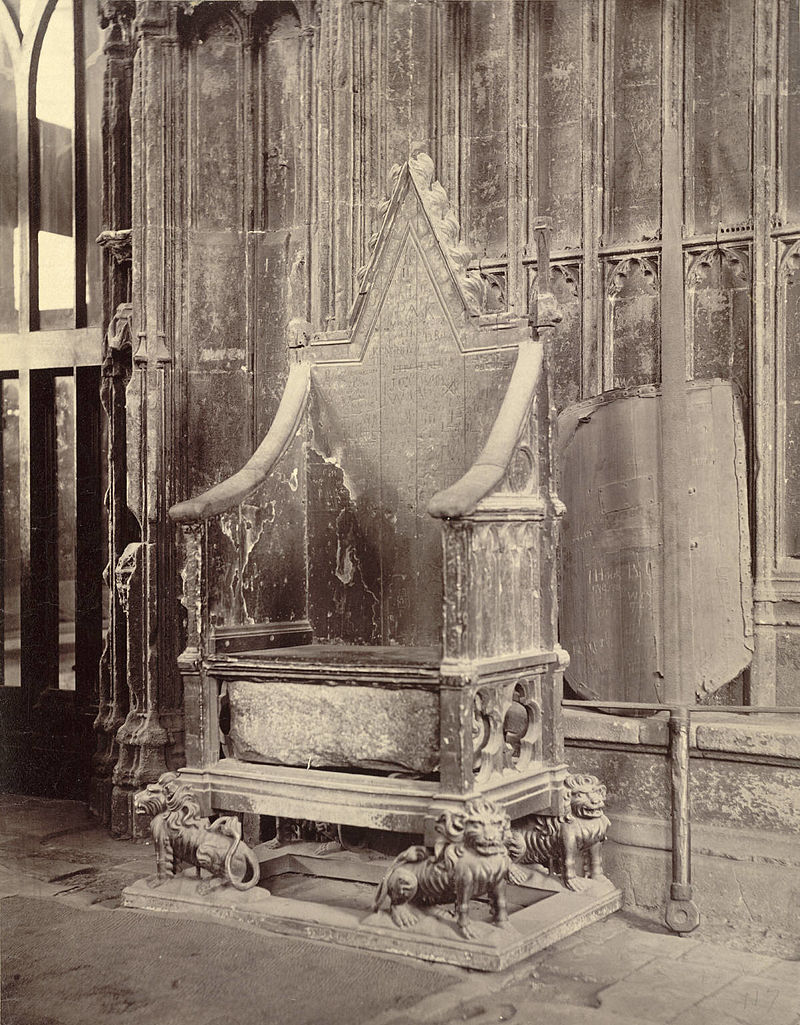After we entered, we were immediately drawn to the centrepiece—the Stone of Destiny itself, displayed with lighting that highlighted its extremely rugged texture and you really got a sense of its historical significance in Scotland.
The stone itself was accompanied with detailed info panels and immersive multimedia displays that described the stone’s origins, the role it played in the coronation of both Scottish and British monarchs, and its journey through time, from being seized by Edward I in 1296 to its historic return to Scotland in the 20th century.
Each section carefully traces the stone’s interesting past, providing real context that connects it to Scotland’s national resilience and enduring pride.
Perth museum has benefited from a £27m renovation (It’s always good to see funding being allocated to cultural enrichment) and the Stone of Destiny Exhibition is the star of the show.
We felt that a standout feature of the exhibition was the interactive timeline with well executed animations and movie clips, which chronicles the Stone’s various travels and explained pivotal moments in Scottish history. We were able to ‘get up close’ to the glass which gave us a real sense of the stone’s texture and composition.

The display didn’t just recount mundane facts but immersed us in the incredible emotions and evocative power struggles of the past, effectively bringing these centuries-old stories to life.
For the younger visitors, there was a dedicated area with tactile replicas to play with and family-friendly explanations which seemed to be a real hit.
The exhibition also explored the broader symbolism of the Stone of Destiny, examining its legendary role in Scotland’s national identity in great detail.
The surrounding exhibits of medieval artefacts and Scottish symbols helped to contextualise the stone’s significance within a wider cultural narrative, allowing visitors to understand and take-in the depth of meaning this artefact holds for Scots today and why this is more relevant today than ever.
Overall, the Stone of Destiny exhibition at Perth Museum is a profound and meticulously curated experience.
The Inverness Design Studio team were particularly interested in the exhibition design aspect from an inspirational point of view, and we left feeling very impressed with the audio visual presentation, interactive displays which the other visitors seemed to really enjoy and the general execution of the exhibition.
What is the Stone of Destiny?
The Stone of Destiny, also known as the Stone of Scone, holds a unique and powerful place in the history of Scotland and the United Kingdom.
This ancient artefact, revered as a symbol of Scottish sovereignty and kingship, has been a crucial part of the coronation ceremonies of Scottish and, later, English and British monarchs for centuries.
The story of the Stone is rich with legend, political significance, and cultural identity, making it one of Scotland’s most iconic historical treasures.
The Origins and Mythology Surrounding the Stone of Destiny
The Stone of Destiny has a history shrouded in myth and legend.
According to tradition, the Stone was brought to Scotland from Ireland by Fergus Mór, the first King of the Scots. Some accounts suggest that its origins extend even further back, possibly to biblical times.
The ancient stories claim that the Stone was the very same used by the biblical patriarch Jacob as a pillow when he dreamt of a ladder to heaven. Whether fact or fable, the mythic origins of the Stone add to its mystique and historical importance.
Over time, the Stone came to be housed at the Abbey of Scone near Perth, Scotland.
This abbey became a sacred location for Scottish royalty, with the Stone serving as a vital part of their crowning ceremonies. The Stone of Destiny’s role in coronations underlined its symbolic importance as the embodiment of Scottish sovereignty.
The Role of the Stone of Destiny in Scottish Coronations
For centuries, the Stone of Destiny was used in the coronation of Scottish kings.
It held a prominent position at Scone Abbey, where Scottish monarchs were enthroned upon it, symbolising their legitimate rule over Scotland. This ritual cemented the Stone’s place in the hearts and minds of the Scottish people as a divine emblem of their nation’s independence and strength.
The coronation ritual held a deeply sacred and unifying force for the Scottish identity, transcending generations and solidifying the Stone as a central feature of Scotland’s monarchical traditions.
The Stone of Destiny’s placement and use at coronations emphasised its role as a national icon. It not only linked the kings to their ancient heritage but also acted as a physical symbol of the continuity of the Scottish throne.
The Stone’s Seizure and Transfer to England
In 1296, the Stone of Destiny was seized by King Edward I of England during his invasion of Scotland. Edward took the Stone as a trophy of war, viewing it as both a powerful symbol and a tool to subdue the Scots by capturing a central piece of their national identity.
The Stone was transported to Westminster Abbey, where it was placed beneath the Coronation Chair, underscoring England’s dominance over Scotland. From that moment, it became intertwined with the English—and later, British—monarchy, being used in the coronations of English kings and queens.

This transfer of the Stone to England marked a profound moment in the history of Scotland.
The Stone of Destiny, once a source of Scottish pride and independence, was now under the control of the English Crown. The Stone’s removal from Scotland was met with sorrow and resentment, as it was seen as a grievous wound to the Scottish nation.
The Return of the Stone to Scotland
After centuries in England, the Stone of Destiny finally returned to Scotland in 1996. Following growing calls for its repatriation, the British government agreed to return the Stone on the condition that it would be transported back to Westminster Abbey for future coronations.
The return ceremony took place in Edinburgh Castle, where the Stone now resides as part of the Crown Jewels of Scotland. This return was a symbolic moment, representing the restoration of an important element of Scottish heritage.
The Stone’s journey back to Scotland not only marked the end of a long period of separation but also reignited Scottish pride and respect for their cultural heritage. It was then held in Edinburgh Castle until it finally made it’s way to Perth Museum.
Discover the Rich Heritage of Perth Museum
Perth Museum, situated in the historic city of Perth in Scotland, is a captivating destination for art, history, and culture enthusiasts. Home to a rich collection of exhibits, the museum reflects the historical tapestry of Perth and Kinross, showcasing centuries of local heritage, artistic endeavours, and scientific Scottish achievements and inventions.
From ancient relics and archaeological discoveries to contemporary art and natural history exhibits, Perth Museum offers visitors an immersive and enlightening experience, celebrating Scotland’s storied past and vibrant present.
Other Exhibits at Perth Museum We Recommend
The Stone of Destiny exhibition was not the only thing worth visiting at Perth Museum. Moving through the building we found a host of other fascinating galleries and educational spaces. Some of our favourites were:
The Art of Scotland: Celebrating Local Artists
The Art Gallery at Perth Museum displays an impressive range of Scottish artwork, including pieces by celebrated artists who capture the unique landscapes, people, and stories of Scotland.
Works from 19th and 20th-century painters depict the rugged beauty of the Highlands, the tranquil lochs, and the rich culture that has shaped Scotland. Visitors can view original works by famous Scottish painters, each piece contributing to a broader narrative of the nation’s artistic heritage.
The Stone of Destiny and Historical Artefacts
Among the museum’s many treasures, the Stone of Destiny holds a special place as an iconic symbol of Scotland’s sovereignty and its historic royal lineage. This legendary artefact, associated with the coronation of Scottish kings, embodies centuries of cultural identity and pride.
Besides the the Stone of Destiny exhibition, there are other historic relics including ancient Roman tools, medieval Scottish weaponry such as the famous claymore sword, and prehistoric artefacts that offer a glimpse into the daily lives, continual warfare, and craftsmanship of Scotland’s early inhabitants going back to the early bronze age.
Natural History: A Window into Scotland’s Landscape
Perth Museum’s natural history section showcases Scotland’s diverse flora & fauna (not just Highland coo’s), geology, and diverse ecosystems (did you know Scotland has it’s very own rainforest?).
Visitors can explore the native wildlife of Perthshire and beyond, with specimens of local bird species, indigenous plants, and geological formations that are unique to the area.
This collection not only highlighted the ecological beauty of Scotland but also promoted the conservation awareness by educating visitors on the importance of preserving Scotland’s natural heritage. Somewhere so special is worth looking after.
Special Exhibitions & Rotating Displays
Perth Museum hosts special exhibitions year round, allowing visitors to experience new themes, artists, and artefacts every time they visit. These temporary exhibitions range from contemporary installations and interactive digital displays (something we offer our customers) to exhibits focusing on Scotland’s tradition of complex and incredible craftsmanship, such as weaving and metalwork. These special exhibitions offer a diverse range of perspectives and show lesser-known aspects of Scottish culture.
We’re sure this helps attract repeat visitors by providing new insights into both historical & modern Scottish life.
Educational Programs and Events
Workshops and Interactive Experiences
We were pleased to see reading some of their promotional leaflets that Perth Museum has a commitment to local community engagement and was evident through the educational programs and workshops they were advertising.
These events are designed to appeal to a wide range of different age-groups and include art workshops, heritage craft sessions, and educational tours tailored to school parties.
Families visiting the museum can enjoy hands-on learning opportunities where children and adults alike can participate in creative projects, like pottery-making, storytelling, and art creation inspired by Scottish heritage.
Lecture Series and Expert Talks
In addition to hands-on workshops, Perth Museum regularly hosts lectures and presentations by historians, artists, and scientists.
These expert-led discussions cover topics ranging from archaeology and natural history to Scottish folklore and contemporary art trends. Such events provide an enriching experience for visitors, allowing them to gain a deeper understanding of the exhibits and the cultural significance behind them.
Amenities and Accessibility at Perth Museum
Museum Cafe and Gift Shop
After visiting the Stone of Destiny exhibition was a cosy cafe where we relaxed and enjoyed a refreshments (they have a wide. selection of hot drinks, beverages and some mouth waveringly good cake!). The gift shop featured unique souvenirs (not the generic gifts found in most museums), a comprehensive assortment of books, and artwork, with a focus on Scottish crafts & products.
Visitors can purchase items like locally created textiles, hand crafted jewellery, and a plethora of artwork created by local artists.
We all decided to take a little piece of Perth Museum’s Stone of Destiny experience home with us.
Accessibility Features
Perth Museum is committed to providing an accessible experience for all visitors.
The museum is equipped with ramps, elevators, and accessible restrooms to ensure a comfortable visit for those with mobility needs. Audio guides, large print materials, and visual aids are also available to enhance accessibility for guests with sensory impairments, allowing everyone to fully experience the museum’s offerings.
We believe the Stone of Destiny exhibition is a good choice for anyone with mobility challenges.
Visiting Perth Museum: Location, Hours, and Ticket Information
Perth Museum is conveniently located in the heart of Perth, making it easily accessible by public transportation and car. Keep an eye out for the parking zones as we were nearly caught out.
The museum is open year-round, though hours may vary from season to season, so visitors are encouraged to check the official website for the most up-to-date information.
We found the admission fees for the Stone of Destiny exhibition to be affordable, and noticed there were discounts available for children, students, and senior citizens/pensioners.
The notice explained that special exhibitions may require additional tickets, but in general admission covers access to the main collections (including the Stone of Destiny exhibition), providing excellent value for money for such an enriching cultural experience. Here are some of the prices we noted as of November, 2024.
| Admission Type | Price |
|---|---|
| Adult | £10 |
| Child (Under 16) | Free |
| Student/Senior | £7 |
| Family Pass (4 Members) | £25 |
Suggested Day Itinerary at Perth Museum
- Morning Arrival – Begin your visit with the Art of Scotland exhibit to experience some of the finest pieces in the museum’s collection.
- Mid-Morning – Move on to the natural history section to learn about Scotland’s ecosystems and local wildlife.
- Lunch Break – Take a break in the museum’s cafe, enjoying Scottish-inspired snacks and refreshments.
- Afternoon – Delve into historical artefacts, including the Stone of Destiny exhibition, and explore rotating special exhibitions.
- Late Afternoon – Visit the gift shop for unique Scottish souvenirs before concluding your visit.
Was it worth visiting the Stone of Destiny Exhibition?
Perth Museum and the Stone of Destiny exhibition offered a unique opportunity to explore Scotland’s cultural, artistic, and natural heritage in one central location.
The museum not only preserves artefacts of great historical value but also promotes an appreciation for Scotland’s art and ecological diversity.
From families seeking a fun, educational day out to historians and art lovers exploring Scotland’s past, Perth Museum provides an experience rich in learning, beauty, and inspiration.
We read the reviews on trip Advisor and found them to be a mixed bag but would we recommend a visit to the Stone of Destiny exhibition? Absolutely! We found the exhibition to be truly fascinating and was executed in a well thought out and engaged our group through every aspect of it’s presentation.



